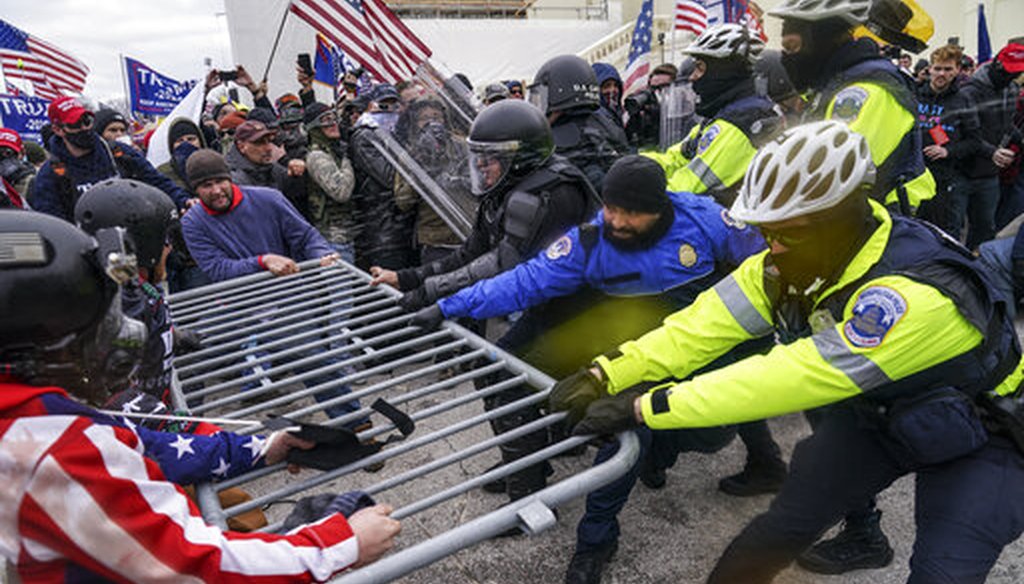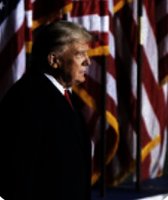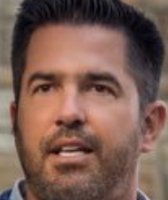Get PolitiFact in your inbox.

Trump supporters try to break through a police barrier, Wednesday, Jan. 6, 2021, at the Capitol in Washington. (AP)
If Your Time is short
-
In 1814, the British burned the Capitol, the president’s house, and other government buildings.
-
Over the following centuries, there were occasional shootings and bombings at the Capitol.
-
The breach on Jan. 6 was unprecedented in modern history. It involved hundreds of people who halted proceedings.
The United States went more than two centuries without an organized breach of its Capitol before Jan. 6, when supporters of President Donald Trump stormed the building as Congress met to certify electoral votes.
CNN hosts Wolf Blitzer and Erin Burnett aimed to put the unprecedented day of chaos in perspective by discussing a statement from Samuel Holliday, director of operations and scholarship at the U.S. Capitol Historical Society. Holliday said it was the first time the Capitol had been breached since the British destroyed the Capitol in 1814 as part of the War of 1812.
Reached by PolitiFact, Holliday slightly adjusted his comparison: "I would say that this is the first time a malicious group has breached the U.S. Capitol since the British in August 1814."
During the Jan. 6 assault, rioters broke windows and loitered in chambers and offices. One woman was shot and died, according to reports. When lawmakers returned to a Capitol clear of rioters, they lamented what happened to their "temple to democracy," as Senate Minority Leader Chuck Schumer called it.
Sen. Cory Booker, D-N.J., drew comparisons to the breaches in 1814 and 2021: While one was another nation trying to challenge the U.S., he said, "this time we brought this hell upon ourselves."
During the War of 1812 against Great Britain, British troops battled their way to Washington in August 1814 and burned down the Capitol and other buildings.
"On Aug. 24, using torches and gunpowder paste, they burned the Capitol, the president’s house, and other government buildings," according to a Senate history. "By the time a summer rainstorm doused the flames, the Capitol was barely more than a burned-out shell. The Senate’s beautiful chamber, according to architect Benjamin Latrobe, was left ‘a most magnificent ruin.’"
Less than a month later, the Senate convened a new session in emergency quarters and considered whether the government should remain in Washington D.C. In 1819, the Senate occupied a rebuilt chamber with the mahogany writing desks still in use today in the modern Senate Chamber.
There have been other violent incidents, including shootings and bombings, at the U.S. Capitol since 1814.
July 2, 1915: A bomb went off in a Senate reception room on the Friday before the Fourth of July weekend shortly before midnight. No one was injured. A former professor of German at Harvard University, Erich Muenter, came to Washington to set off the package of dynamite. Muenter wrote that he hoped that the detonation would "make enough noise to be heard above the voices that clamor for war. This explosion is an exclamation point in my appeal for peace." Days later in jail, Muenter took his own life.
March 1, 1954: As House members gathered for an upcoming vote, four members of the Puerto Rican Nationalist Party entered the gallery armed with handguns, according to a House history.
"They indiscriminately opened fire onto the House Floor and unfurled a Puerto Rican flag in a violent act of protest meant to draw attention to their demand for Puerto Rico’s immediate independence," states the House history website.
Five congressmen were wounded. House members, pages and police officers helped detain three of the assailants outside the gallery, while the fourth escaped the Capitol and was apprehended later that afternoon.
March 1, 1971: A bomb exploded in the Capitol building, causing damage but hurting no one. The Weather Underground claimed credit for the bombing as a protest of the ongoing U.S.-supported Laos invasion.
Nov. 7, 1983: At 10:58 p.m., a bomb tore through the second floor of the Capitol’s north wing while the adjacent halls were virtually deserted. Minutes before the blast, a caller claiming to represent the "Armed Resistance Unit" warned the Capitol switchboard that a bomb had been placed near the chamber in retaliation for recent U.S. military involvement in Grenada and Lebanon. Five years later, federal agents arrested six members and charged them with the bombing. Three were later sentenced to prison while the court dropped charges against three co-defendants, already serving extended prison sentences for related crimes.
"The 1983 bombing marked the beginning of tightened security measures throughout the Capitol," states the Senate website. "The area outside the Senate Chamber, previously open to the public, was permanently closed. Congressional officials instituted a system of staff identification cards and added metal detectors to building entrances to supplement those placed at chamber gallery doors following a 1971 Capitol bombing."
July 24, 1998: Two Capitol Police officers, Officer Jacob J. Chestnut, Jr., and Detective John M. Gibson, were shot and killed when an armed assailant stormed past a U.S. Capitol security checkpoint. The shooter, Russell Eugene Weston Jr., was found incompetent to stand trial.
We asked Holliday why he considered the Jan. 6 breach the first one since 1814 in light of some of these other shootings.
He said none of the other incidents were similar to the scale of the Jan. 6 events.
"The 1954 shooting in the House galleries by a group of Puerto Rican nationalists has similar elements, but they smuggled their weapons inside the building before staging their attack," he said in an email. "The tragedy in 1998 involved a lone gunman who got inside the building. It’s admittedly a fine distinction, but I think it’s an important one."
RELATED: A day of crisis at the US Capitol, fact-checked
RELATED: Is this a coup? Here’s some history and context to help you decide
Our Sources
U.S. Senate, A Capitol in Ruins, 1814
U.S. Senate, The Senate Convenes in Emergency Quarters, 1819
U.S. Senate, Bomb Rocks Capitol, July 2, 1915
History.com, War of 1812
U.S. House of Representatives, 1954 Shooting in the House Chamber
U.S. House of Representatives, The 1998 Shooting of Two Capitol Police officers
This Day in History, Bomb explodes in Capitol building, March 1, 1971
U.S. Senate, Bomb Explodes in Capitol, Nov. 7, 1983
Washington Post, A history of violence at the U.S. Capitol, March 28, 2016
Washington Post, In 1814, British forces burned the U.S. Capitol, Jan. 6, 2021
Washington Post, Capitol Shooter's Mind-Set Detailed, April 23, 1999
Fox 4 Kansas City, A history of shootings, other violent attacks at the US Capitol, Jan. 6, 2021
PBS, 101 years of security incidents at the U.S. Capitol, March 28, 2016
PolitiFact, A day of crisis at the US Capitol, fact-checked, Jan. 6, 2021
Email interview, Samuel Holliday, director of operations and scholarship at the U.S. Capitol Historical Society, Jan. 6, 2021
Sen. James Lankford, R-Oklahoma, Tweet, Jan. 6, 2021
Sen. Cory Booker, D-New Jersey, Senate speech, Jan. 6, 2021








































